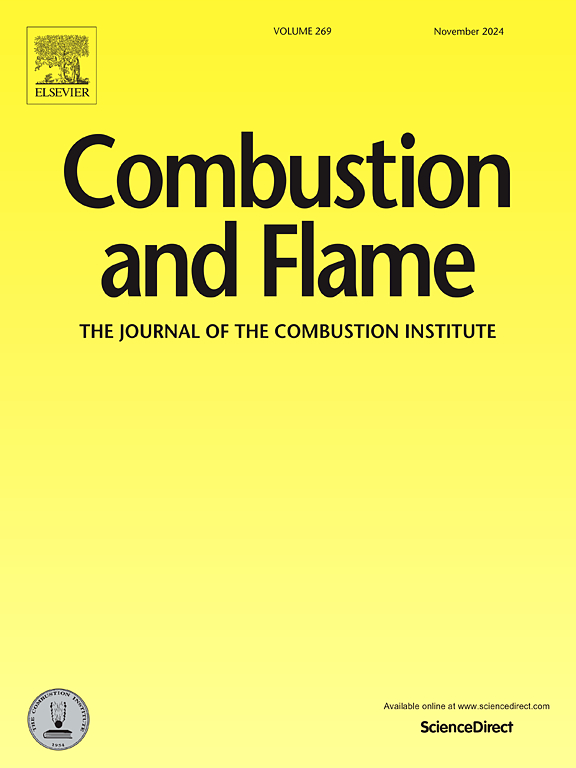Kinetic development of low-temperature propane oxidation in a repetitively-pulsed nanosecond discharge
IF 6.2
2区 工程技术
Q2 ENERGY & FUELS
引用次数: 0
Abstract
The kinetics of plasma assisted low temperature oxidation of mixtures have been studied in a wide specific deposited energy with the help of nanosecond repetitively pulsed discharge. Two types of nanosecond pulsed plasma sources, the nanosecond capillary discharge (nCD) and dielectric barrier discharge (DBD) combined with the synchrotron photoionization mass spectrometry are investigated. The electron impact reaction rate of propane dissociation and some combustion chemical reactions rate constants are updated according to the nCD and DBD experiment results, and uncertainty of the reactions are analyzed in detail. Compared to the existing model, the updated model’s prediction accuracy has great improvement in species , , , , , , , , , -, -, , - and . The propane oxidation processes assisted by DBD and nCD were compared under different single pulse deposited energy (SPDE) conditions while maintaining the same total deposited energy. The reduced electric field in nCD is concentrated at 150-200 Td and 450-500 Td, whereas in DBD it ranges from 1-100 Td and 260-380 Td. Notably, for nCD at different voltages with a similar reduced electric field distribution, SPDE shows minimal influence on the oxidation process, which is primarily governed by total deposited energy. nCD is more effective discharge form for contribute to dissociation compared to DBD.
Novelty and significance statement
The study of plasma assisted fuel conversion and efficient combustion requires precise data on plasma chemistry and combustion chemical reaction kinetics. However, the computational complexity of excited state reaction kinetics data based on first principles is enormous, resulting in a scarcity of relevant basic data. Propane, as a relatively large molecule, is an important object for studying its low-temperature oxidation pathway in plasma ignition and combustion assistance. The research that was lacking in the early stage mainly used analogy estimation and limited experimental research on a few reactions. In this work we revised the reaction kinetics mechanism of propane low-temperature oxidation reaction by constructing two independent experiments, and discussed the general effects of energy deposition and electric field (which are the key parameters of a plasma system) on propane plasma low-temperature oxidation. This study can serve as a foundation and reference for studying plasma pyrolysis of macromolecular fuels.
重复脉冲纳秒放电低温丙烷氧化动力学发展
在纳秒重复脉冲放电的帮助下,研究了等离子体低温氧化C3H8/O2/Ar混合物的动力学。研究了两种纳秒脉冲等离子体源,即纳秒毛细管放电(nCD)和介质阻挡放电(DBD)结合同步加速器光离质谱法。根据nCD和DBD实验结果,更新了丙烷解离的电子冲击反应速率和一些燃烧化学反应速率常数,并对反应的不确定度进行了详细分析。与现有模型相比,更新后的模型对H2O、CO2、CH4、CH2O、CH3OH、C2H2、C2H6、C2H5OH、C2H5OOH、C3H4-A、C3H4-P、C2H5CHO、i-C3H7OH和C3H7OOH等物种的预测精度有较大提高。在保持总沉积能量不变的情况下,比较了DBD和nCD在不同单脉冲沉积能量条件下的丙烷氧化过程。nCD的还原电场集中在150 ~ 200 Td和450 ~ 500 Td,而DBD的还原电场集中在1 ~ 100 Td和260 ~ 380 Td。值得注意的是,对于不同电压且电场还原分布相似的nCD, SPDE对C3H8氧化过程的影响最小,主要受沉积总能量的影响。与DBD相比,nCD是促进C3H8解离的更有效的排放形式。新颖性和意义声明等离子体辅助燃料转化和高效燃烧的研究需要等离子体化学和燃烧化学反应动力学的精确数据。然而,基于第一性原理的激发态反应动力学数据的计算复杂性巨大,导致相关基础数据的缺乏。丙烷作为一种相对较大的分子,是研究其低温氧化途径在等离子体点火助燃中的重要对象。早期缺乏的研究主要是对少数反应进行类比估计和有限的实验研究。本文通过构建两个独立实验,修正了丙烷低温氧化反应的反应动力学机理,并讨论了能量沉积和电场(等离子体系统的关键参数)对丙烷低温氧化的一般影响。本研究可为研究大分子燃料的等离子体热解提供基础和参考。
本文章由计算机程序翻译,如有差异,请以英文原文为准。
求助全文
约1分钟内获得全文
求助全文
来源期刊

Combustion and Flame
工程技术-工程:化工
CiteScore
9.50
自引率
20.50%
发文量
631
审稿时长
3.8 months
期刊介绍:
The mission of the journal is to publish high quality work from experimental, theoretical, and computational investigations on the fundamentals of combustion phenomena and closely allied matters. While submissions in all pertinent areas are welcomed, past and recent focus of the journal has been on:
Development and validation of reaction kinetics, reduction of reaction mechanisms and modeling of combustion systems, including:
Conventional, alternative and surrogate fuels;
Pollutants;
Particulate and aerosol formation and abatement;
Heterogeneous processes.
Experimental, theoretical, and computational studies of laminar and turbulent combustion phenomena, including:
Premixed and non-premixed flames;
Ignition and extinction phenomena;
Flame propagation;
Flame structure;
Instabilities and swirl;
Flame spread;
Multi-phase reactants.
Advances in diagnostic and computational methods in combustion, including:
Measurement and simulation of scalar and vector properties;
Novel techniques;
State-of-the art applications.
Fundamental investigations of combustion technologies and systems, including:
Internal combustion engines;
Gas turbines;
Small- and large-scale stationary combustion and power generation;
Catalytic combustion;
Combustion synthesis;
Combustion under extreme conditions;
New concepts.
 求助内容:
求助内容: 应助结果提醒方式:
应助结果提醒方式:


